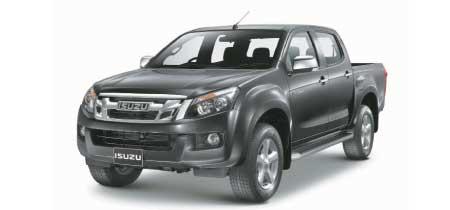The new generation Isuzu D-MAX has been recently launched in the Thai market.
Seen for the first time globally at the Thai launch in Bangkok, the revealing of the all new Isuzu D-MAX has presented an exciting new model lineup of the new generation 1-tonne utility.
As a production model, the design and specifications are indicative of what will be on offer when the product reaches our shores next year.
As an entirely new generation vehicle, the Isuzu D-MAX styling and design parts ways from the current model and previously associated competitors.
Exterior and interior highlights
Modern and sleek exterior lines compliment the new bulkier and aggressive on-road stance. The larger exterior dimensions afford a considerable increase in interior space raising occupant comfort levels and improving the rear seat access in crew and space cab models.
A stylish and contemporary dash compliments the interior design. Functional upgrades include increased stowage areas. A new audio system features portable music player connectivity and Bluetooth.
Engine upgrades
Power and torque have both been improved through the technological refinement of Isuzu’s 3.0L diesel power-plant. The upgraded inline 4-cylinder diesel delivers a peak torque output of 380Nm and peak power output of 130kW. The torque is delivered across a flat curve through a large majority of the rev-range to aid drivability and make ease of towing.
As expected from an Isuzu diesel, it delivers outstanding fuel economy even with the increased power and torque outputs.
An all new automatic transmission offers a refined shift map through 5 speeds. This joins the 5-speed manual in the range.
Chassis Development
A newly developed ladder frame chassis in the D-MAX builds on the engineering successes of the platform. It features a stiffer design with improved cross bracing at the rear, further improving stability while both loaded and while towing. It also ensures long term durability when used regularly in harsh environments.
An increased length wheel base from the current ute body’s 3050mm to 3095mm is now standard across the entire vehicle lineup.
Focus on safety
With a growing importance on occupant safety, the new D-MAX has focused in this area as a top priority.
New side airbags that deploy from the side bolster of the front bucket seats protect the driver and passenger thorax region from side impact forces. Also featured are side curtain airbags to further protect occupants in these situations. A front driver and passenger system complete the array of airbags offered as standard.
Electronic stability control is also now fitted as standard.
The new Emergency brake assist and anti-lock brake system are designed to detect an emergency braking situation during hard application of the brakes. These systems work in unison to slow the vehicle without locking up the wheels and aiding stability. Electronic brake distribution further assists by detecting the payload weight and modulating the rear breaking force to compensate.
The exact model range and pricing for the New Zealand range is yet to be finalised but it is expected a similar range to the current offer should become available.
Mercedes-Benz chose the IAA International Motor Show in Frankfurt to present the new 2012 DTM AMG Mercedes C-Coupé. The new car is the successor to the AMG Mercedes C-Class, which scored 84 victories in 156 races to become the most successful vehicle in the 27-year history of the DTM. HWA AG began development, design and construction of the DTM AMG Mercedes C-Coupé in June 2010. The first chassis was assembled in June 2011, with the first vehicle completed in August.
The DTM AMG Mercedes C-Coupé was designed to meet the new and improved safety concept for 2012, which includes a state-of-the-art carbon fibre monocoque and a roll cage made of high strength steel. In order to improve driver protection in the event of an accident, all safety-related components such as the fire extinguishing system and fuel tank have been incorporated into the monocoque. Furthermore, each vehicle is equipped with six crash structures to give the driver additional protection to the front, rear and sides. These carbon fibre crash structures are designed to gradually absorb impact energy, so that the driver is not exposed to high deceleration forces.
The new safety concept was developed jointly by rights holder and promoter ITR e.V., the DMSB and the three manufacturers – Audi, BMW and Mercedes-Benz. In order to verify the performance of the DTM safety concept, the DMSB developed a test programme, which was carried out and analyzed by DEKRA, the independent testing organization. All tests were completed without any problems.
The new DTM AMG Mercedes C-Coupé is based on the latest Mercedes-Benz C-Class Coupé, which celebrated its world premiere in summer 2011. The C-Class Coupé rounds off Mercedes-Benz best-selling range and is offered with a choice of five engines – two diesel and three petrol units – developing from 115 kW (156 hp) to 225 kW (306 hp). The C-Class Coupé is manufactured at the Mercedes-Benz plant in Bremen. It’s the fourth model to be built on a single production line alongside the saloon and estate versions, plus GLK – a new production method for Daimler.
DTM offers spectators racing like no other touring car series. Viewers in 83 countries can follow DTM either live or as-live. A total of 5,881 hours of DTM racing were shown worldwide on TV in 2010. In Germany last year, 89 hours of TV coverage generated an estimated 480 million TV contacts. On every race weekend of the 2011 season, an average of approximately 2.4 million TV viewers watched coverage of qualifying and the race on ARD television.



